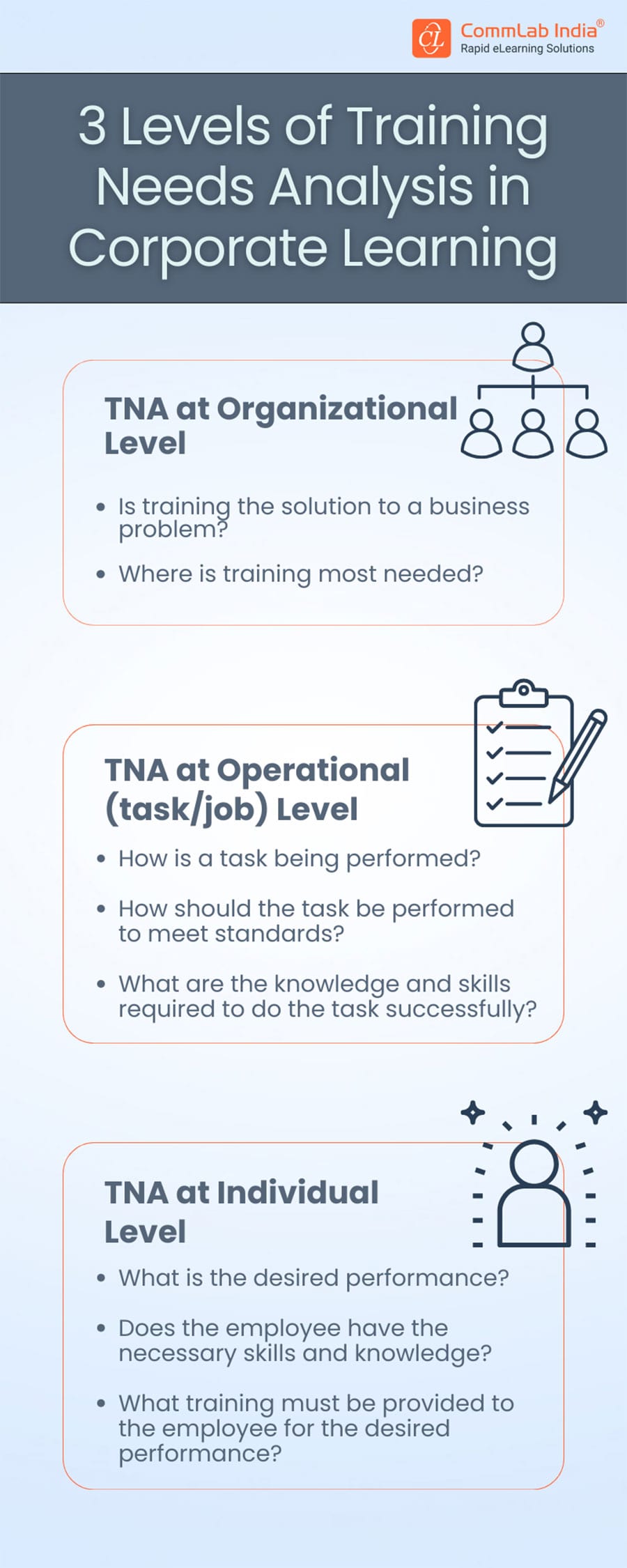What are the 3 Levels of Training Needs Analysis [Infographic]
![What are the 3 Levels of Training Needs Analysis [Infographic] What are the 3 Levels of Training Needs Analysis [Infographic]](https://blog.commlabindia.com/hubfs/blogs/training-needs-analysis-levels-corporate-training-info.jpg)
Have you ever wondered why some training programs seem to fall short of their intended goals? Like is it possible that the area of focus of such training programs might not really have been on point? It's a question worth pondering, especially when the success of an organization's training initiatives hangs in the balance. And to set the record straight, training programs can sometimes miss the mark for various reasons. One common issue is a misalignment between the goals of the training and the actual needs of the individuals or the organization.
To tackle this problem and achieve the desired training results, focusing on Training Needs Analysis is a must. And to do so, this blog is all you need. It’ll cover the concept of Training Needs Analysis, its need to ensure effective training initiatives, and lastly the 3 levels of Training Needs Analysis (TNA) in corporate training.
So without any delay, let’s begin.
What is Training Needs Analysis (TNA)?
To start with, think of Training Needs Analysis (TNA) as the compass guiding your training initiatives toward success. That’s right! TNA is the systematic process of identifying the gaps between current and desired employee performance levels, and then determining the training interventions necessary to bridge those gaps effectively.
→ Free eBook: How L&D And Business Can Align to Conquer The Future Of Work
The Need for TNA in Corporate Training
Below are some major reasons why conducting TNA is essential for successful training initiatives.
Helps in Strategic Alignment
By conducting a thorough Training Needs Analysis (TNA), you can rest assured that your training efforts are aligned with the strategic goals of the organization. It enables you to identify specific areas where skill enhancement is needed. Moreover, using the insights gathered from TNA, you can curate training programs to address the desired learning objectives effectively. This alignment ensures that every training initiative contributes meaningfully to the company's bottom line.
Ensures Optimized Resource Utilization
For any organization, time and resources are precious commodities. This is particularly true in the case of corporate training. Spending them on not-so-important areas negatively influences the training effectiveness and is reflected in terms of low training ROI, missing the mark of set business goals. But with thorough TNA, you can ensure that the resources are invested wisely by directing them toward areas where they will yield the highest returns. By identifying which department requires what kind of training, you can allocate resources efficiently. It helps maximize the impact of your training investments.
Employee Engagement and Satisfaction
Employees are the lifeblood of any organization. Ensuring their engagement and satisfaction in training programs directly impacts productivity and retention. And in this process, TNA plays a central role. It enables organizations to identify employees’ learning needs and cater to them. This fosters employee engagement as it demonstrates the organization’s commitment to its employees’ professional development. This in turn makes employees feel valued and supported which leads to higher levels of engagement, job satisfaction, and reduced turnover rates.
Now that we understand why TNA is so important, let's explore the three levels at which it can be conducted.
3 Levels of Training Needs Analysis in Corporate Learning
To Sum It Up!
Training Needs Analysis (TNA) is the backbone of effective corporate training initiatives. It enables you to systematically identify training gaps and align training efforts with your organizational goals. This helps ensure that training programs are strategic, targeted, and impactful. On this note, check out our free eBook to understand how L&D and business can align for a successful future of work.







